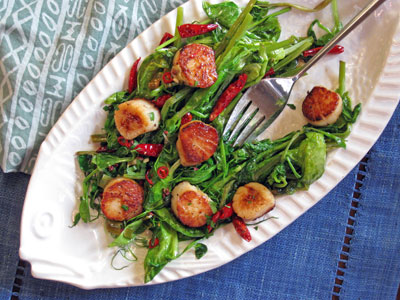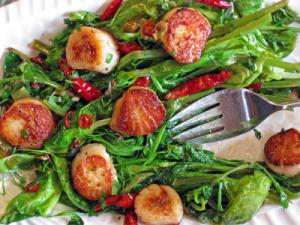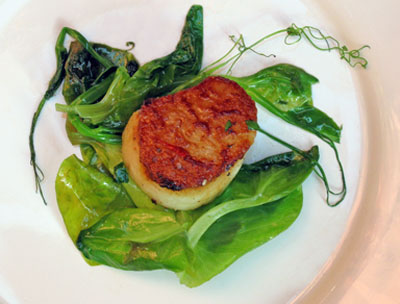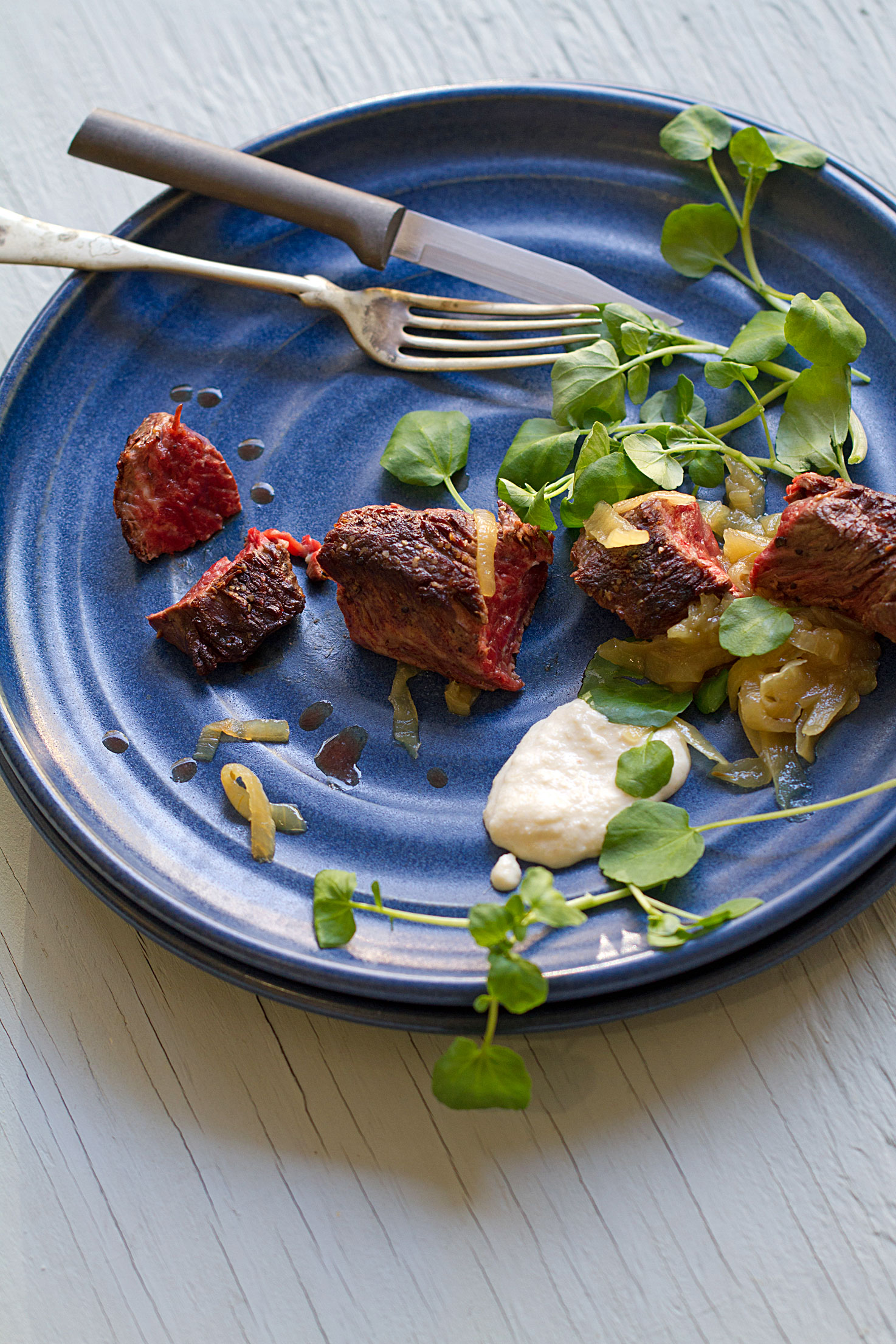 How many times has this happened to you?
How many times has this happened to you?
You are leafing through a magazine or cookbook, or maybe you are cruising through a few good food blogs. You come across a gorgeous photo of thick meaty scallops. They are seared to a crispy golden brown. But you just know they are sweet and juicy on the inside. They are oh so simply presented, sitting beside some lovely veggies or atop a creamy plate of risotto.
You actually salivate. You scan the recipe. Butter, oil, all the usual suspects. Okay, you decide, “I can do this”. You are a good cook. You know you are.
You know to use a straight-sided sauté pan. Not a sloped style fry pan. You are not stupid. You know the pan can’t be too big because you want to radiate some heat. But you are savvy enough not to crowd them into a small pan either. Who wants steamed scallops. You weren’t born yesterday.
You rush to the store. Oh look, a big bag a frozen scallops is on sale at Costco. You do not really need 10 pounds. But hey, they are frozen. They’ll keep right?
 But like I said you are a good cook and you have noticed that those big frozen scallops tend to disappoint you for some reason. You can’t put your finger on it. But sometimes the sweet, full fresh taste of the sea is abridged by a faintly metallic taste.
But like I said you are a good cook and you have noticed that those big frozen scallops tend to disappoint you for some reason. You can’t put your finger on it. But sometimes the sweet, full fresh taste of the sea is abridged by a faintly metallic taste.
You drop the bag back into the freezer case and head for the fish counter. No, this time you are not going to be taken in by the price.
This time you are splurging on fresh. The recipe seems to deserve it. Besides, cooking scallops is practically simplistic. It’s like a filet mignon. You put it in a hot pan and cook to just past rare. Who can’t do that?
You get to the counter to look for some help. How come there is never the same guy working here twice? They certainly do have a heck of a rotation of knowledgeable fishmongers at this place, you convince yourself.
But none of that matters because there they are; the scallops of your dreams. Nearly as big as a fist, and oh so heavy. Juicy too! They are practically weeping with moisture. Now you are weeping. The lady next to you starts to cry. It’s time to focus…
These are the ones. Sure they cost an arm and a leg. But how much can a dozen really cost you anyway. Oh! $25.00. Really… “Ah, screw it. It’s only money” you decide. You grunt and throw a dozen over your shoulder and lug them home with you.
When you spend this kind of money on a first course you want it to be good. So you take your time with the mis en place. You get everything just so.
You heat some canola oil. When it’s good and hot you gently slide those babies into the pan. You know to let them be. You resist the urge to move them about the pan a lot. Too much love and you won’t get that gorgeous golden brown color you saw in the photos. They will release themselves from the pan when they are good and ready. This much you know.
So you stand there and wait. Clicking your tongs to that old Madonna tune you have going on in your mind “…Borderline, feels like I’m going to lose my mind…Borderline”.
But you make it the entire 3 minutes without disturbing them. You start to flip those sweethearts over.
The first thing you notice is how much moisture these guys gave up in cooking. I mean you appreciate the facial and all. But these scallops are half the size they started. Maybe you should have gotten 16 of them. You silently hope there are enough for everyone.
And another thing. Where is that golden brown color you envied in the photos?? Yours are a creamy translucent milky color of white. They smell done. The recipe clearly says: 3 minutes undisturbed on one side and then another minute or two on the other side.
Maybe it’s a typo.
Maybe your pan was not hot enough.
You turn the heat up and that’s when it happens. You make your fatal error.
“I’ll cook them a couple more minutes and then they will be that perfect golden hue I was promised”.
Sound Buzzer. End Of Game.
You have blown it. Your scallops are going to be over-cooked and rubbery. In trying to achieve that perfect crackly golden exterior, you over-cooked your $22.50 a pound monsters. You wanted crisp on the outside, but succulent in the inside. But it’s too late. I am sorry. They are ruined.
Like I said you ARE a good cook. This problem would happen to any one of us because it is not your fault! In fact it’s a conspiracy. I know because little green men in Roswell, New Mexico told me so!
There is a dirty little secret out there in seafood land. It’s called STP. It’s not motor oil. But to a connoisseur it’s nearly as bad. Sodium tripolyphosphate.
It’s the bugger responsible for that metallic taste and it’s what keeps your scallops from browning up properly
As far as I can tell, the additive was originally designed to get scallops to absorb water. It keeps frozen scallops from drying out during the freezing and thawing process. It is routinely added to scallops frozen at sea.
But nowadays STP is often added to non-frozen scallops, prior to soaking them in water, as a way of causing them to absorb the water and increase their weight.
There is always a boogeyman and money is the root of all evil.
As you probably figured the supplier charges by the pound. The now water-laden scallop is considerably heavier. There are now far fewer scallops per pound. The supplier is happy but the cook is devastated.
As necessary as phosphates are with seafood frozen at sea. These same phosphates are easily abused. If a little STP can keep the natural moisture in seafood, imagine what a lot can do. Well you don’t have to imagine because I’ll tell you. It can cause a scallop to soak up so much water that it can increase in weight up to 25 percent.
And if that is not bad enough then look in your pan. There is so much excess moisture your results are steamed, rubbery scallops that will not brown properly not matter how high the heat or how long they stay in the pan, under the broiler, or on the grill.
 So give yourself a break. The familiar tale I cited here is REALLY not your fault.
So give yourself a break. The familiar tale I cited here is REALLY not your fault.
So now not only do we have to consider how sustainable our seafood harvesting practices are, and weigh the benefits of fresh or frozen, wild-caught or farmed. We have to wonder if our scallops are wet or dry.
Which is not the same as “dried”. It’s far more complicated.
Wet scallops are the ones treated with STP. The STP gives scallops a longer shelf life; they don’t dry out or lose their plump appearance. I live on the west coast. Very, very good scallops are not in our back yard. I went a lot of years eating the wet scallops because they are very prevalent here.
Non-treated dry scallops are harder to come by (for me…). So you have to ask questions. You even have to educate the people at some fish counters. Some of them will give you attitude about it. Shop elsewhere.
Good fishmongers will know the difference or will at least be open to hearing the information.
It’s your money. They are your scallops. It’s your right to know what you are paying for. Because STP or no, very good scallops can be in excess of $20.00 a pound (in my neck of the woods).
The ball’s in your court…If you want to see what I did (once I got some dry scallops). Click on any photo for the recipe: Seared Scallops with Pea Tendrils and Sichuan Peppercorns.

SERIOUS FUN FOOD
Greg Henry
SippitySup

Those frozen bags of scallops from Costco do NOT have STP. They’re the only ones I can find that don’t, and they sear up nice and brown and have that rich scallop flavor.
You’re right, in 2019 they do not have STP. In 2008, the last time I bought them there, they did. GREG
You are absolutely right on !!!! I have been aware of STP for years and you just described my most recent experience. Those large Japan farm scallops called to me.…i know all about STP so i thought i would deep fry them because the pan thing is just as you stated. I have only tasted that metallic taste in bay scallops before. I shook them in a baggie with stone groundmeal (very much recommended for all frying, bound batters suck unless they are 1/4 inch thick-like in popcorn shrimp, when the batter is structual !) Would you know, the large scallops were way metallically. So i was trying to see if the STP had a taste, you were my first read and you described the whole scallop to kitchen to mouth so very perfectly.…the only thing good about STP is that you feel so intelligent asking the fishmonger if his fish have it or explainin’ to other folks why it is nasty. I did not know the metallic taste comes from that, but THANKS so much for the education. Almost ALL FROZEN SEAFOOD products have it now, that is why i and saving the frozen fish i recently bought for crab bait, i hope they like it !